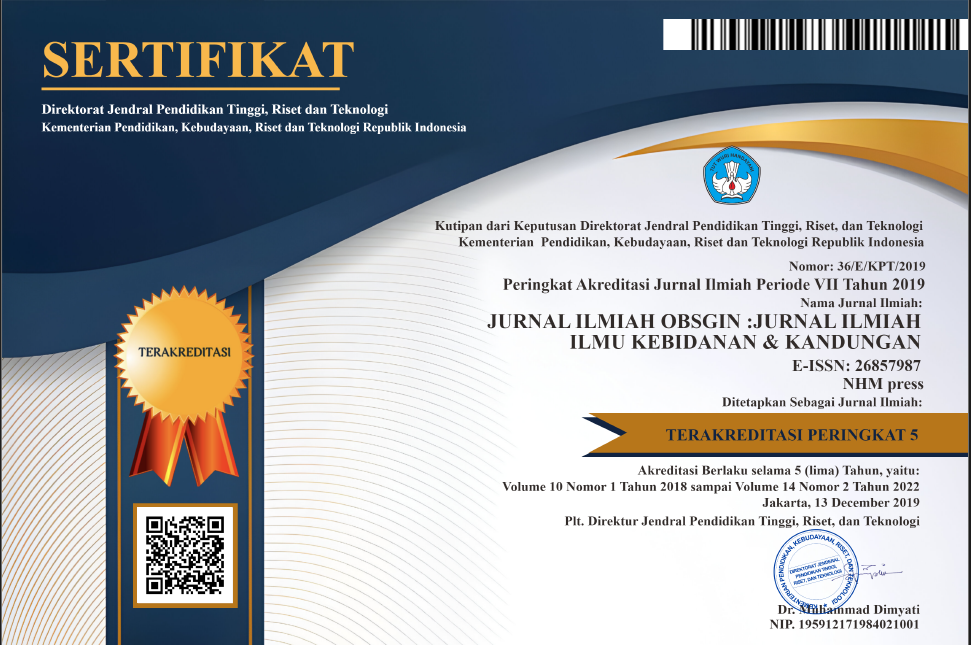HUBUNGAN TINGKAT KEPATUHAN WANITA USIA SUBUR (WUS) DALAM SKRINING HPV-DNA DENGAN KEJADIAN SUSPECT KANKER SERVIKS DI TOTAL LIFE CLINIC SURABAYA
Abstract
Cervical cancer is the second most common of all cancer cases in Indonesia (Kemenkes RI, 2021). Prevention of cervical cancer can generally be done through routine screening activities and it has been proven that early detection can reduce the incidence rate. The aim of this study was to determine the relationship between the level of compliance of women of childbearing age (WUS) in HPV-DNA screening and the incidence of suspected cervical cancer at Total Life Clinic Surabaya. The design of this research is correlational analytic with a cross sectional approach. The population in this study were all women of childbearing age (WUS) who underwent HPV-DNA examination at the Total Life Clinic Surabaya from July 2022 to December 2023, a total of 38 patients. Total sampling technique. The instruments used in this research were observation sheets and notes made by the researcher. Data analysis uses the contingency test to determine the significance of the relationship between variables. The results showed that the majority of women of childbearing age (WUS) complied with HPV-DNA screening as many as 29 people (76.3%), the incidence of suspected cervical cancer was mostly in the undetected category, namely 34 people (89.5%) and 4 people ( 10.5%) were diagnosed with cervical cancer, there was a relationship between compliance with HPV-DNA screening and the incidence of cervical cancer in WUS at the Total Life Clinic using the contingency coefficient test p-value=0.011. Women who do not comply with cervical cancer screening have a higher risk of being diagnosed with suspected cervical cancer due to delays in detection and treatment of possible precancerous or cancerous conditions. Therefore, it is important to increase awareness, access, and compliance with cervical cancer screening among WUS to reduce this risk.
References
Alwahaibi, N., Alsalami, W., Alramadhani, N., & Alzaabi, A. (2018). Factors Influencing Knowledge and Practice Regarding Cervical Cancer and Pap smear Testing among Omani Women. Asian Pacific Journal of Cancer Prevention : APJCP, 19(12), 3367–3374. https://doi.org/10.31557/APJCP.2018.19.12.3367
Aoki, E. S., Yin, R., Li, K., Bhatla, N., Singhal, S., Ocviyanti, D., Saika, K., Suh, M., Kim, M., & Termrungruanglert, W. (2020). National screening programs for cervical cancer in Asian countries. Journal of Gynecologic Oncology, 31(3), 1–9. https://doi.org/10.3802/jgo.2020.31.e55
Aprianti, A., Fauza, M., & Azrimaidalisa, A. (2019). Faktor yang Berhubungan dengan Deteksi Dini Kanker Serviks Metode IVA di Puskesmas Kota Padang. Jurnal Promosi Kesehatan Indonesia, 14(1), 68. https://doi.org/10.14710/jpki.14.1.68-80
Brianti, P., De Flammineis, E., & Mercuri, S. R. (2017). Review of HPV-related diseases and cancers. New Microbiol, 40(2), 80–85.
Burd, E. M. (2003). Human papillomavirus and cervical cancer. Clinical Microbiology Reviews, 16(1), 1–17. https://doi.org/10.1128/CMR.16.1.1-17.2003
Canadian Cancer Society. (2024). Risk Factors for Cervical Cancer. Cancer.Ca.
Catarino, R., Vassilakos, P., Petignat, P., & Combescure, C. (2022). Harms and benefits of cervical cancer screening among non-attenders in Switzerland: The transition towards HPV-based screening. Preventive Medicine Reports, 29(July), 101929. https://doi.org/10.1016/j.pmedr.2022.101929
Chan, C. K., Aimagambetova, G., Ukybassova, T., Kongrtay, K., & Azizan, A. (2019). Human Papillomavirus Infection and Cervical Cancer: Epidemiology, Screening, and Vaccination - Review of Current Perspectives. Journal of Oncology, 2019. https://doi.org/10.1155/2019/3257939
Cui, Z., Kawasaki, H., Tsunematsu, M., Cui, Y., & Kakehashi, M. (2022). Factors Affecting the Cervical Cancer Screening Behaviors of Japanese Women in Their 20s and 30s Using a Health Belief Model: A Cross-Sectional Study. Current Oncology, 29(9), 6287–6302. https://doi.org/10.3390/curroncol29090494
Dahiya, N., Aggarwal, K., Singh, M., Garg, S., & Kumar, R. (2019). Knowledge, attitude, and practice regarding the screening of cervical cancer among women in New Delhi, India. Tzu Chi Medical Journal, 31(4), 240–243. https://doi.org/10.4103/tcmj.tcmj_145_18
Darmawan, J. (2022a). Tes HPV DNA Lebih Direkomendasikan Untuk Skrining Kanker Serviks. Alomedika.Com.
Darmawan, J. (2022b). Tes HPV DNA Lebih Direkomendasikan Untuk Skrining Kanker Serviks.
de la Motte Rouge, T., Touboul, C., Lhomel, C., Rouprêt, M., & Morère, J.-F. (2021). Factors associated with compliance to cervical cancer screening in France: The EDIFICE 6 survey. Gynecologic Oncology, 160(1), 112–117. https://doi.org/10.1016/j.ygyno.2020.10.032
Di Giuseppe, G., Folcarelli, L., Lanzano, R., Napolitano, F., & Pavia, M. (2022). HPV Vaccination and Cervical Cancer Screening: Assessing Awareness, Attitudes, and Adherence in Detained Women. Vaccines, 10(8). https://doi.org/10.3390/vaccines10081280
Dwi, A. (2023). Cara Menyusun Kerangka Teori Dalam Karya Ilmiah. Fkip.Umsu.Ac.Id.
Edi, I. G. M. S. (2015). Faktor-Faktor Yang Mempengaruhi Kepatuhan Pasien Pada Pengobatan Telaah Sistematik. Jurnal Ilmiah Medicamento, 1(1), 1–8. https://doi.org/10.36733/medicamento.v1i1.719
Endale, H., Mulugeta, T., & Habte, T. (2022). The Socioeconomic Impact of Cervical Cancer on Patients in Ethiopia: Evidence from Tikur Anbessa Specialized Hospital. Cancer Management and Research, 14(May), 1615–1625. https://doi.org/10.2147/CMAR.S352389
Ghosh, S., Jayaram, P., Kabekkodu, S. P., & Satyamoorthy, K. (2022). Targeted drug delivery in cervical cancer: Current perspectives. European Journal of Pharmacology, 917, 174751. https://doi.org/https://doi.org/10.1016/j.ejphar.2022.174751
Kemenkes RI. (2021). Profil Kesehatan Indonesia 2020.
Kominfo. (2020, February). Serviks dan Payudara, Dominasi Kanker di Jawa Timur. Dinas Kominfo Propinsi Jawa Timur.
Kusmiyati, Y., Prasistyami, A., Wahyuningsih, H. P., Widyasih, H., & Adnani, Q. E. S. (2019). Duration of hormonal contraception and risk of cervical cancer. Kesmas, 14(1), 9–13. https://doi.org/10.21109/kesmas.v14i1.2713
Limmer, K., LoBiondo-Wood, G., & Dains, J. (2014). Predictors of Cervical Cancer Screening Adherence in the United States: A Systematic Review. J Adv Pract Oncol, 5(1), 1.
Membrilla-Beltran, L., Cardona, D., Camara-Roca, L., Aparicio-Mota, A., Roman, P., & Rueda-Ruzafa, L. (2023). Impact of Cervical Cancer on Quality of Life and Sexuality in Female Survivors. In International Journal of Environmental Research and Public Health (Vol. 20, Issue 4). https://doi.org/10.3390/ijerph20043751
Murewanhema, G., Dzobo, M., Moyo, E., Moyo, P., Mhizha, T., & Dzinamarira, T. (2023). Implementing HPV-DNA screening as primary cervical cancer screening modality in Zimbabwe: Challenges and recommendations. Scientific African, 21, e01889. https://doi.org/https://doi.org/10.1016/j.sciaf.2023.e01889
Nunes, M. F., Leite, A. H., & Dias, S. F. (2021). Inequalities in adherence to cervical cancer screening in Portugal. European Journal of Cancer Prevention, 30(2). https://journals.lww.com/eurjcancerprev/fulltext/2021/03000/inequalities_in_adherence_to_cervical_cancer.8.aspx
Nursalam. (2020). Metodologi Penelitian Ilmu Keperawatan (Peni Puji Lestari (ed.); edisi 5). Salemba.
Okunade, K. S. (2020). Human Papillomavirus and Cervical Cancer. J Obstet Gynaecol, 40(5), 602–608. https://doi.org/10.1080/01443615.2019.1634030.Human
Origoni, M., Cristoforoni, P., Costa, S., Mariani, L., Scirpa, P., Lorincz, A., & Sideri, M. (2012). HPV-DNA testing for cervical cancer precursors: From evidence to clinical practice. Ecancermedicalscience, 6(1), 1–15. https://doi.org/10.3332/ecancer.2012.258
Pranitia, R., Thaufik, S. H., Sakundarno Adi, M., Budijitno, S., Epidemiologi Universitas Diponegoro, M., & Obstetri dan Ginekologi RSUP dr Kariadi Semarang, D. (2021). Riwayat Melahirkan dan Riwayat Merokok sebagai Faktor Risiko Kejadian Kanker Serviks pada Wanita Usia >35 Tahun. Care: Jurnal Ilmiah Ilmu Kesehatan, 9(1), 97–103.
Price, P. C., Jhangiani, R. S., Chiang, I.-C. A., Leighton, D. C., & Cuttler, C. (2017). Research Methods in Psychology. In Journal of Environmental Psychology (Vol. 14, Issue 4). https://doi.org/10.1016/s0272-4944(05)80228-2
Putri Damayanti, I. (2013). Faktor-faktor yang Berhubungan dengan Kejadian Kanker Serviks di RSUD Arifin Achmad Pekanbaru Tahun 2008-2010. Jurnal Kesehatan Komunitas, 2(2), 88–93. https://doi.org/10.25311/keskom.vol2.iss2.51
Ratnasari, N. V., & Toyibah, A. (2018). Relationship of Working Period in Tobacco Industry with Cervical Precancerous. Jurnal Berkala Epidemiologi, 6(1), 69. https://doi.org/10.20473/jbe.v6i12018.69-76
Rosa, E. M. (2018). Kepatuhan (Compliance). Mars.Umy.Ac.Id.
Wanda, M., Oktavia, N. S., & Elda, Y. (2018). Faktor-faktor yang Berhubungan dengan Kejadian Preeklamsi Berat di RSUP Dr. M. Djamil Padang Tahun 2018. Jurnal Ilmu Kesehatan (JIK), 2(April), 79–85.
WHO. (2022). Cervical Cancer. Who.Int. https://www.who.int/news-room/fact-sheets/detail/cervical-cancer
Zhang, S., Xu, H., Zhang, L., & Qiao, Y. (2020). Cervical cancer: Epidemiology, risk factors and screening. Chinese Journal of Cancer Research, 32(6), 720–728. https://doi.org/10.21147/j.issn.1000-9604.2020.06.05
Zhang, W., Gao, K., Fowkes, F. J. I., Adeloye, D., Rudan, I., Song, P., Jin, M., & Chen, K. (2022a). Associated factors and global adherence of cervical cancer screening in 2019: a systematic analysis and modelling study. Globalization and Health, 18(1), 1–11. https://doi.org/10.1186/s12992-022-00890-w
Zhang, W., Gao, K., Fowkes, F. J. I., Adeloye, D., Rudan, I., Song, P., Jin, M., & Chen, K. (2022b). Associated factors and global adherence of cervical cancer screening in 2019: a systematic analysis and modelling study. Globalization and Health, 18(1), 101. https://doi.org/10.1186/s12992-022-00890-w
Zoodsma, M., Sijmons, R. H., de Vries, E. G., & Zee, A. G. van der. (2004). Familial cervical cancer: case reports, review and clinical implications. Hereditary Cancer in Clinical Practice, 2(2), 99–105. https://doi.org/10.1186/1897-4287-2-2-99.











